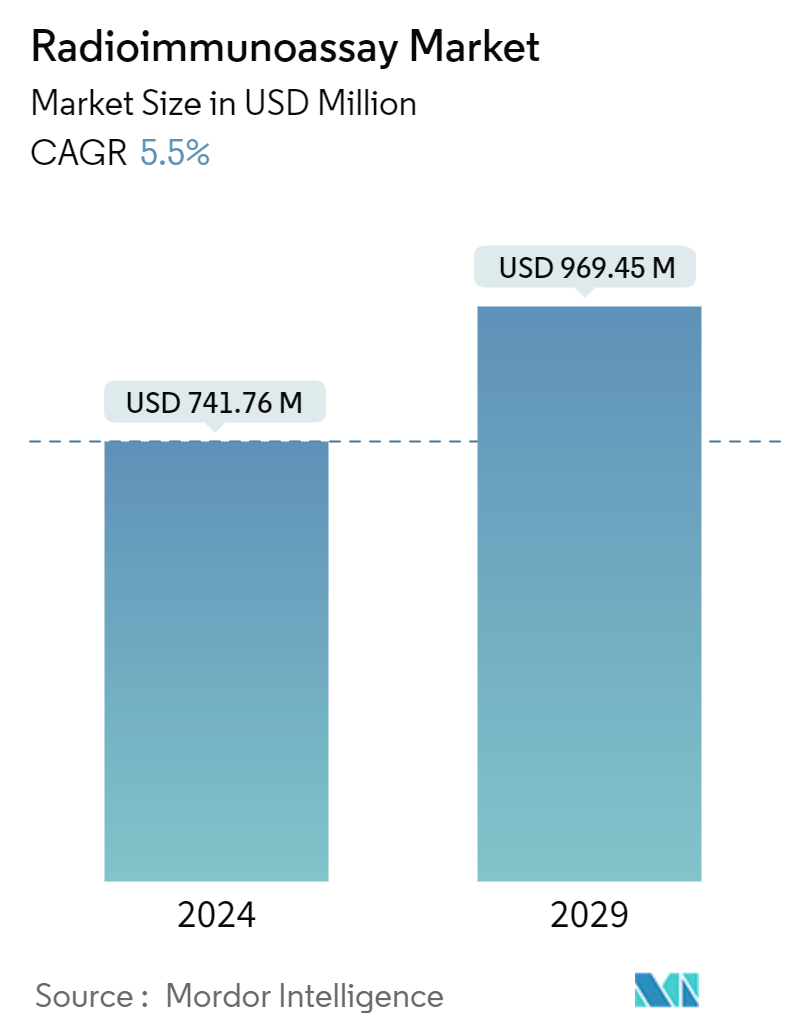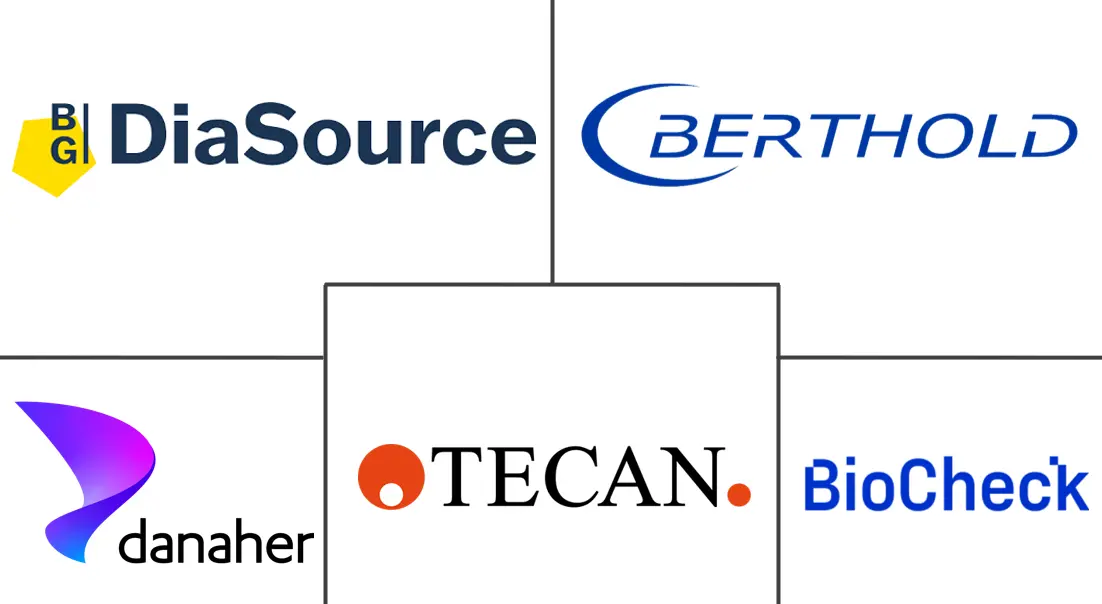Market Size of Radioimmunoassay Industry

| Study Period | 2019 - 2029 |
| Market Size (2024) | USD 741.76 Million |
| Market Size (2029) | USD 969.45 Million |
| CAGR (2024 - 2029) | 5.50 % |
| Fastest Growing Market | Asia Pacific |
| Largest Market | North America |
Major Players
*Disclaimer: Major Players sorted in no particular order |
Radioimmunoassay Market Analysis
The Radioimmunoassay Market size is estimated at USD 741.76 million in 2024, and is expected to reach USD 969.45 million by 2029, growing at a CAGR of 5.5% during the forecast period (2024-2029).
- Radioimmunoassay (RIA) techniques remain a cornerstone in the realm of research and clinical diagnostics, offering unparalleled precision and sensitivity in measuring hormones, drugs, and other vital substances in biological samples. The evolution of this market is heavily influenced by the increasing demand for accurate diagnostic tools, particularly amid the rising prevalence of cancer and infectious diseases. In addition, continuous technological advancements are enhancing the efficacy and broadening the scope of radioimmunoassay procedures, solidifying their place in modern diagnostics.
Applications and Technological Advancements in Radioimmunoassay
- Wide Application Spectrum: Radioimmunoassay applications are diverse, spanning across multiple sectors including research and clinical diagnostics. The growing need for reliable assay methods in these sectors has bolstered the demand for radioimmunoassay kits and instruments, essential for detecting and quantifying various analytes. These tools are invaluable in medical fields, especially in diagnosing conditions like cancer and hormone disorders.
- Technological Innovations: The continuous pursuit of improved diagnostic accuracy has driven significant innovation in RIA technologies. Notably, newer radioimmunoassay reagents and instruments are being developed to meet these demands, enhancing both sensitivity and specificity. These advancements are crucial in reducing diagnostic errors and expanding the application of RIA across different healthcare segments.
Market Dynamics: Rising Demand vs. Competitive Pressures
- Growing Demand for Advanced Diagnostics: The global increase in cancer and infectious diseases has heightened the need for precise and reliable diagnostic tools. Radioimmunoassay procedures are indispensable in early detection and disease management, providing accurate biomarker measurements critical for both diagnosis and treatment. This surge in health conditions underscores the growing importance of RIA in clinical diagnostics.
- Technological Edge: The ongoing advancements in radioimmunoassay instruments and reagents are pivotal in expanding the market. These innovations, such as more efficient RIA kits with faster turnaround times, are not only improving procedural efficiency but are also broadening the scope of RIA applications in sectors like pharmaceuticals and research.
- Competitive Challenges: The high cost of RIA equipment and the hazards of radioactive materials are significant barriers to wider adoption. Additionally, alternative immunoassay procedures like enzyme-linked immunosorbent assay (ELISA) and chemiluminescence immunoassay (CLIA) offer safer, more cost-effective options, challenging RIA's dominance in the market. These alternatives, free from the complexities of handling radioactive substances, are increasingly favored by laboratories.
- Challenges in Adoption: Despite its advantages, the adoption of radioimmunoassay techniques faces hurdles, particularly due to the high costs associated with RIA equipment and the risks posed by radioactive materials. These factors contribute to cautious adoption rates, especially in regions with budget constraints and stringent safety regulations.
Radioimmunoassay Industry Segmentation
As per the scope of the report, radioimmunoassay refers to a very sensitive, specific laboratory test or assay that uses radiolabeled and unlabeled substances in an immunological, i.e., antibody-antigen reaction. In this method, any biological substance for which a specific antibody exists can be measured, even in minute concentrations.
The radioimmunoassay market is segmented by product, application, end-user, and geography. By product, the market is segmented into analyzers and reagents & kits. By application, the market is segmented into research and clinical diagnostics. By end user, the market is segmented into hospitals, clinical diagnostic laboratories, pharmaceutical industries, and other end users. By geography, the market is segmented into North America, Europe, Asia-Pacific, the Middle East and Africa, and South America. The market report also covers the estimated market sizes and trends of 17 countries across major regions globally. The report offers the value (in USD) for the above segments.
| By Product | |
| Analyzers | |
| Reagents and Kits |
| By Application | |
| Research | |
| Clinical Diagnostics |
| By End User | |
| Hospitals | |
| Clinical Diagnostic Laboratories | |
| Pharmaceutical Industries | |
| Other End Users |
| Geography | ||||||||
| ||||||||
| ||||||||
| ||||||||
| ||||||||
|
Radioimmunoassay Market Size Summary
The radioimmunoassay market is poised for significant growth, driven by the increasing prevalence of chronic diseases such as cancer and infectious diseases, alongside technological advancements in diagnostic tools. The market's expansion is further bolstered by the heightened demand for precise diagnostic methods during the COVID-19 pandemic, which underscored the importance of radioimmunoassay in serological testing. The method's inherent specificity, high throughput, and sensitivity make it a preferred choice in clinical diagnostic laboratories for analyzing a wide range of biological samples. Despite challenges such as the high cost of equipment and the use of hazardous materials, the market is expected to benefit from ongoing research and regulatory support, particularly in regions like North America, where there is substantial investment in healthcare infrastructure and R&D.
The market landscape is moderately competitive, with key players like Danaher, Berthold Technologies, and DIAsource Immunoassays holding significant shares. Innovations such as the development of new immunoassays and compliance with regulatory standards, like the EU In Vitro Diagnostics Regulation, are expected to enhance market growth. The introduction of advanced diagnostic methods, such as those for measuring cardiovascular disease biomarkers, further supports the market's trajectory. As the demand for effective diagnostic solutions continues to rise, the radioimmunoassay market is anticipated to experience robust growth, driven by its critical role in disease diagnosis and the ongoing development of new applications and technologies.
Radioimmunoassay Market Size - Table of Contents
-
1. MARKET DYNAMICS
-
1.1 Market Overview
-
1.2 Market Drivers
-
1.2.1 Rising Prevalence and Incidence of Cancer and Infectious Diseases
-
1.2.2 Technological Advancements
-
-
1.3 Market Restraints
-
1.3.1 High Cost of Equipment Required for Radioimmunoassay and Hazardous Radioactive Materials
-
1.3.2 Continuous Innovations in Various Other Immunoassay Procedures
-
-
1.4 Porter's Five Forces Analysis
-
1.4.1 Bargaining Power of Buyers/Consumers
-
1.4.2 Bargaining Power of Suppliers
-
1.4.3 Threat of New Entrants
-
1.4.4 Threat of Substitute Products
-
1.4.5 Intensity of Competitive Rivalry
-
-
-
2. MARKET SEGMENTATION (Market Size by Value - in USD)
-
2.1 By Product
-
2.1.1 Analyzers
-
2.1.2 Reagents and Kits
-
-
2.2 By Application
-
2.2.1 Research
-
2.2.2 Clinical Diagnostics
-
-
2.3 By End User
-
2.3.1 Hospitals
-
2.3.2 Clinical Diagnostic Laboratories
-
2.3.3 Pharmaceutical Industries
-
2.3.4 Other End Users
-
-
2.4 Geography
-
2.4.1 North America
-
2.4.1.1 United States
-
2.4.1.2 Canada
-
2.4.1.3 Mexico
-
-
2.4.2 Europe
-
2.4.2.1 Germany
-
2.4.2.2 United Kingdom
-
2.4.2.3 France
-
2.4.2.4 Italy
-
2.4.2.5 Spain
-
2.4.2.6 Rest of Europe
-
-
2.4.3 Asia-Pacific
-
2.4.3.1 China
-
2.4.3.2 Japan
-
2.4.3.3 India
-
2.4.3.4 Australia
-
2.4.3.5 South Korea
-
2.4.3.6 Rest of Asia-Pacific
-
-
2.4.4 Middle East and Africa
-
2.4.4.1 GCC
-
2.4.4.2 South Africa
-
2.4.4.3 Rest of Middle East and Africa
-
-
2.4.5 South America
-
2.4.5.1 Brazil
-
2.4.5.2 Argentina
-
2.4.5.3 Rest of South America
-
-
-
Radioimmunoassay Market Size FAQs
How big is the Radioimmunoassay Market?
The Radioimmunoassay Market size is expected to reach USD 741.76 million in 2024 and grow at a CAGR of 5.5% to reach USD 969.45 million by 2029.
What is the current Radioimmunoassay Market size?
In 2024, the Radioimmunoassay Market size is expected to reach USD 741.76 million.

